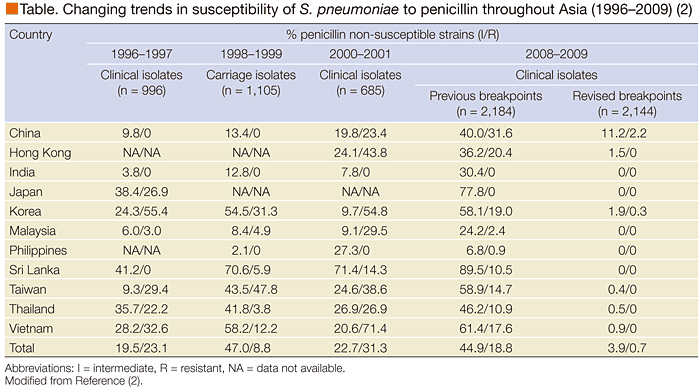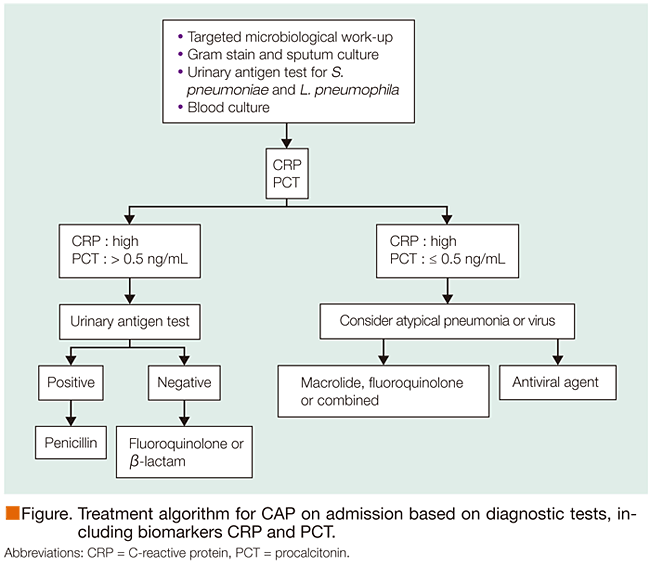The Treatment of Community-Acquired Pneumonia with Consideration of Mycobacterium Tuberculosis
The Role of Fluoroquinolones in the Treatment of Community-Acquired Pneumonia in Taiwan


Fluoroquinolones have been used in Taiwan for more than 10 years in the successful treatment of a range of infections, particularly those affecting the respiratory tract. To evaluate whether they still have a role to play in the treatment of CAP, Dr. Gwan-Han Shen, Taichung Veterans General Hospital, Taiwan, presented a comprehensive update about relevant pathogen susceptibility and resistance profiles and how these trends need to be considered when developing optimal treatment strategies that will maintain the efficacy of fluoroquinolones well into the future.
Dr. Shen presented an update on the current etiological isolates responsible for CAP in Taiwan and Asia, and the clinical application of this data to ensure the continued efficacy of antimicrobials, including fluoroquinolones. Streptococcus pneumoniae remains the primary causative CAP pathogen in Taiwan, responsible for 24% of disease in hospitalized adults (1). However, atypical pathogens are responsible for an almost equal number of cases (Mycoplasma pneumoniae 14%, Chlamydia pneumoniae 7%, Legionella pneumophila 1%) while Mycobacterium tuberculosis is only identified in 1% of CAP patients.
Looking in more detail at S. pneumoniae, the most common pneumococcal serotypes in Taiwan include serotype 14, 3 and 23F, although there has been a greater than four-fold increase in the incidence of serotype 19A since 2010, especially in children. However, the clinical impact of this is reduced by its continued susceptibility to fluoroquinolones and low mortality rate of 4.1%. In contrast, while the incidence of serotype 9V is low, it is of concern due to its higher fluoroquinolone resistance and associated mortality rate of 30.9%.
Extending the data to include 11 Asian countries, Dr. Shen reported on results from a recent prospective surveillance study of 2,184 S. pneumoniae isolates that clarifies changing trends of antimicrobial resistance and serotypes throughout the region (Table) (2). What at first appeared surprising were that the latest 2008-2009 results reporting all non-meningeal isolates of S. pneumoniae in Taiwan remained susceptible to penicillin, with only 2.2% of these isolates resistant in China. This is in stark contrast to previous data reporting penicillin-resistant S. pneumoniae(PRSP) rates ranging from 58.4% to 60.5% (3). However, Dr. Shen explained that the marked change was due to the breakpoint definition for penicillin resistance changing from 2 mg/L to 8 mg/L, rather than any change in minimum inhibitory concentration (MIC) values.

Turning to other classes of antimicrobials, Dr. Shen reported that macrolide-resistant S. pneumoniae (MRSP) rates have now reached a staggering 84.9% in Taiwan, and resistance to clindamycin and trimethoprim-sulfamethoxazole is high at 55.0% and 61.9%, respectively. Multidrug resistance remains a significant concern reaching 59.7% in Taiwan, 83.0% in China, 75.5% in Vietnam, 63.9% in Korea and 62.2% in Hong Kong. In contrast, S. pneumoniae resistance to fluoroquinolones remains low.
Another commonly identified CAP pathogen, Haemophilus influenzae, has been shown to exhibit increasing resistance, with 55 to 56% of these isolates producing β-lactamase (4). However, in Taiwan, while 23% of these isolates are resistant to amoxicillin-clavulanic acid (4), 100% remain susceptible to fluoroquinolones (5).
Fluoroquinolones have also maintained their efficacy against Klebsiella pneumoniae, with less than 5% resistant to levofloxacin (6). In addition, the usefulness of fluoroquinolones is heightened by their activity against both methicillin-susceptible Staphylococcus aureus (MSSA) and methicillin-resistant S. aureus (MRSA) (7).
In addition to covering the typical CAP pathogens, the data presented by Dr. Shen highlighted the need for antimicrobials to cover atypical pathogens, which are responsible for 22% to 25% of CAP (1, 8). Treatment regimens that provide coverage of these pathogens are associated with improved outcomes and a reduction in the time required to achieve clinical stability, the length of hospital stay and the total mortality rate. However, the problem is how to differentiate between typical and atypical pathogens clinically. To help in the identification of causative pathogens, Dr. Shen used a range of diagnostic tests (microbiological analysis, Gram stain, sputum culture, urinary antigen tests for the pneumococcus and Legionella) to present a therapeutic algorithm for managing CAP patients. He began by noting that patients in whom S. pneumoniae is identified by Gram stain and urinary antigen test should be treated with macrolides, β-lactams or fluoroquinolones. However, if the Legionella urinary antigen test is positive, they should be treated with levofloxacin, a macrolide, or a combination of these.
To help improve diagnosis of causative pathogens, biomarkers such as procalcitonin (PCT) and C-reactive protein (CRP) along with cytokine activation patterns have been investigated, and Dr. Shen included these in his algorithm (Figure).

A patient with a high CRP and high PCT (> 0.5 ng/mL) level is likely to have a bacterial infection, and in such patients, S. pneumoniae, H. influenzae and K. pneumoniae must be considered. The patient should then have a pneumococcal urinary antigen test and, if positive, should be treated with penicillin, or in regions with high rates of PRSP, treated with fluoroquinolones. If the pneumococcal urinary antigen test is negative, other pathogens including H. influenzae, K. pneumoniae, Pseudomonas aeruginosa, Acinetobacter spp., S. aureus and other rare pathogens must be covered. In these patients fluoroquinolones should be used, either alone or in combination with β-lactams.
In patients with a leukocytosis identified by a high CRP and a low PCT, atypical pathogens as well as viruses should be suspected. In these patients a rapid influenza test could be used and, if positive, oseltamivir should be administered. In those with a bacterial infection fluoroquinolones, macrolides, or vancomycin should be used, with Dr. Shen noting that the time to achieve clinical stability is shorter with fluoroquinolones than with macrolides.
Another bacterial pathogen responsible for CAP is M. tuberculosis and Dr. Shen stressed the need to consider this possibility in all patients presenting with CAP, due to the issue of potentially masking the infection with antimicrobial treatment. This is particularly important in regions with a higher proportion of CAP caused by M. tuberculosis.
However, due to the difficulties in diagnosing M. tuberculosis, Dr. Shen said that clinicians should be aware that a number of clinical and laboratory predictors of patients with TB who were initially diagnosed as having CAP have been identified. These include symptoms longer than 2 weeks prior to admission, a cavity infiltrate, a chest X-ray with upper lobe involvement, WBC levels ≤ 12×109/L, night sweats and lymphopenia. By considering these factors, Dr. Shen hoped that clinicians would be able to reduce the incidence of delayed diagnosis of TB.
References
(1) Lauderdale TL, et al. Respir Med 2005; 99(9): 1079-86.
(2) Kim SH, et al. Antimicrob Agents Chemother 2012; 56(3): 1418-26.
(3) Jean SS, et al. J Formos Med Assoc 2011; 110(1): 4-13.
(4) Chung KP, et al. J Infect 2011; 62(2): 185-7.
(5) Ko KS, et al. Diagn Microbiol Infect Dis 2006; 55(4): 337-41.
(6) Wang H, et al. Int J Antimicrob Agents 2011; 38(5): 376-83.
(7) Chen YH, et al. J Antimicrob Chemother 2009; 64(6): 1226-9.
(8) Song JH, et al. Int J Antimicrob Agents 2008; 31(2): 107-14.











